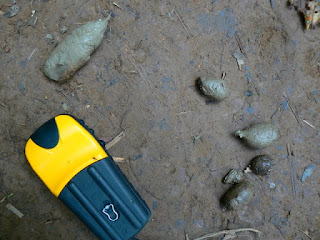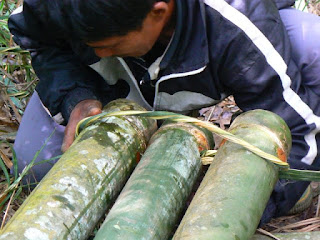The Hmong guy Lao Bii, was Tui’s friend, they knew each other from when Tui’d been to Nambo before.
I'm going to apologise in advance for anything I get wrong. I don't know much about the Hmong. I've met and talked to plenty in Thailand, China, and America, but I really don't know much about the way they live in the more traditional setting of rural Laos.
At first we waited for Lao Bii in the yard, he was out hunting birds like all guys do at the end of the day. With seemingly every guy in the village out looking for birds every afternoon you have to wonder how there are any birds left. But there are, and there always have been.
When Tui's friend returned we went inside. After setting our packs down, slipping off our boots and donning flip flops, we went to off find people I’d taken photos of two years before. I always try to hand out a copy of a photo to anyone I take a picture of.
We also stopped in and said hi to the soldiers stationed in the village, and Tui showed them some sort of documentation authenticating my permission to be gallivanting about.. Since my last visit the government sent fourteen soldiers including two political officers and a teacher to live in the village.
On realizing that I could follow the conversation I remarked to one of the soldiers, “you speak Lao”, he grunted and looked at me as if to say “what were you expecting, Swahili?” The lingua franca of this district is Lu, I usually understand none of it. The soldier was of Kahmu ethnicity, perhaps from an entirely different region of Laos. These soldiers were from the central government, not the provincial authorities.
Luang Namtha province is an opium producing area, and the government is interested in curtailing the production. The opium grown isn’t refined but rather consumed by locals as a recreational drug or as medicine. Opium is also the primary cash crop in the area, used to buy lead shot, LED light bulbs, batteries, antibiotics, clothes, and all other manufactured goods from the outside world.
Things have changed for the better in Nambo in the two years since I’d last seen it. The kids seemed healthier and had better clothes, houses had been enlarged and improved. I stopped in front of the house I’d stayed in before and watched the building of a new house. The village is made of combined Lahu and Hmong ethnic groups, an attempt by the government to form larger villages, why I’m not sure.

Photo from 06 of moonrise and dead tree
you can see the same dead tree as in the moonrise photo above, same tree, just a little deader.
The view to the south is mostly of Mount (Phou) Mon Lem. Tui was so used to seeing the mountain from a different side that at first he didn’t believe it to be the same hill. The Hmong guys eavesdropping set him straight. It’s easy to mistake a mountain that has such a large base, the perspective is much different depending on how close you are to which side. Phou Mon Lem and it’s flanks separate the drainage of the Nam (river) Fa and the Nam Long with the ridge extending all the way down to the Mekong.
Phou Mon Lem
With the onset of dark we returned to Lao Bii's house. Tui told me that a couple of years ago our host had been required to turn himself in at the district capital and submit to being placed under arrest and jailed for shooting a nuah pah (wild cow). I don’t know if it was a banteng or a gaur, both animals are against the law to hunt in Laos and probably endangered. His family had to gather up $1,000 to pay the fine to release him. That's a lot of money for a subsistence farmer.
Gaur, one of the largest land animals. Photo is from some travel company in Thailand that does trips to Khao Sok National Park, one of the few photos I could find from the wild, (don't like zoo photos). I lost the link, if anyone reading knows the name of the company please email and I'll include a link, credit where credit is due.
In the area around Muang Long there is no international trade in endangered wildlife. The route to China is long and the authorities are aware of most that happens in their district. The rules regarding which species of big game to hunt are followed. Medium sized deer, bamboo rat, pig, that sort of thing are allowed, large and perhaps endangered animals aren’t.
No one really knows how many of which species exist in Laos. In the state where I live in the US they have done extensive research on cougars over many decades and yet current population estimates rage from five to seven thousand animals. That’s a pretty inaccurate number given all the radio collaring, DNA of scat samples, and computer modeling that is done. In Laos where there are none of these tools and very few scientists doing research all numbers are determined using the WAG method. (Wild Ass Guess)
Looking at things from the perspective of indigenous peoples you can see where there might be some consternation. The same people have been living in the hills of Laos for centuries, using the same methods of hunting and farming. Species endangerment, and habitat loss have nothing to do with the way they hunt or farm, and everything to do with the way we buy patio furniture and the way the Chinese buy cars with tires.
Phou Mon Lem on Google Earth without vertical exageration. Ignore the "route 3" cutting over the top, no idea how lines are drawn on google maps. The yellow line in the far distance is the international border of Laos/Burma formed by the Mekong.
A few years ago a wild elephant in musth appeared down by Xiengkok and started trampling houses and killing people. The authorities sent people ahead of the animal and attempted to warn those in it’s path while desperately seeking permission to kill the thing. The head of the district contacted the provincial governor who contacted his superiors in Luang Prabang and eventually permission was granted from the prime minister in Vientiane. No one wanted to take responsibility.
I got this story after spotting a large bone in the restaurant called Joey. I knew the bone was way too big for any animal I’d ever heard of. People figure it swam the Mekong from Burma in that wild testosterone induced craziness that male elephants sometimes go through. There are no wild elephants in Bokeo or Luang Namtha side of things, maybe up by that transnational protected area close to Boten and Sipsongbana, but not down by Long and Xiengkok.
Elephant Bones
With the sun fully down we returned to our host’s house. I took a more leisurely look at the inside.
The Hmong live differently from the lowland Lao and Tai I’m used to. For one thing they live on the ground not up on stilts. Living on the mountain they are never in danger of flood. The roof was a very nice split wooden shake, no need to constantly replace roof straw or put up with the drops of condensation off a metal roof.
Lao Bii and his youngest
The house seemed quieter, no constant squawking of chickens or snorting of pigs from under foot. Warmer too, no breeze blowing through the split bamboo floor. The floor itself though of dirt is not dirty but shiny from the polishing of many feet.
The fire is in a large square block of mud/clay. The wood is fed from the front and a very large wok sits snugly on a hole on top. It is a very basic stove, saving on firewood and heating the house when the fire is out via the large mass of the clay.
I notice they cook rice differently also. First in the wok until the water boils, then transferred to a basket which sits on top of the boiling water and the rice is steamed until done. I like it. The rice is wetter, and I like my rice wet. Below the roof, strung from the rafters so to catch the smoke, a roll of sausage made from the small intestine of a pig and unidentified hunks of fat.
Sausage and probably pig fat
I’ve no recollection of the night, only of the eldest wife blowing the coals to start the morning fire before sunup.


































